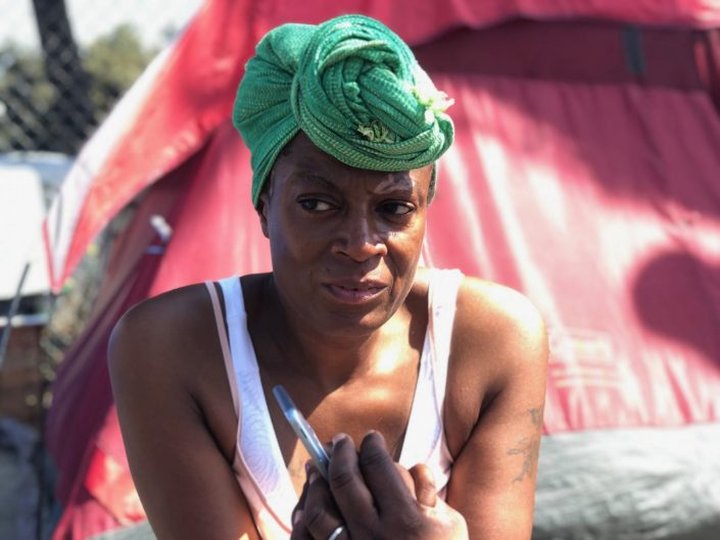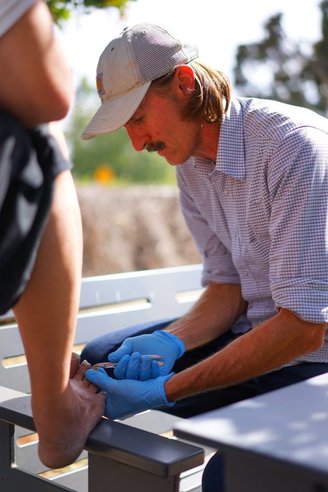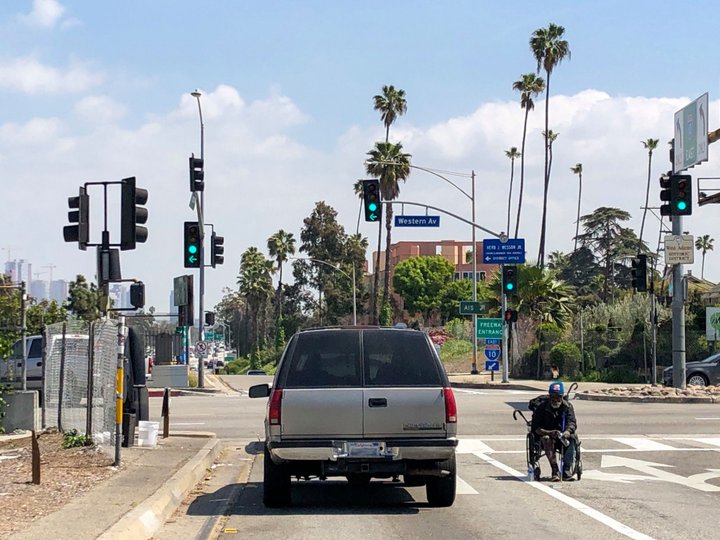Matt Tinoco, KPCC, CALmatters / Monday, Sept. 30, 2019 @ 8:03 a.m.
‘Sicker Than the Rest of Us' -- Docs Make House Calls to People Without Houses

Shawnda Thornton, who has been homeless for about three years, lives in Venice, CA. Photo courtesy of Coley King.
###
Dr. Coley King of the free Venice Family Clinic is one of a growing number of medical professionals making house calls to people who are homeless.
Instead of trying to powerwash the problem away, California’s hospitals, public health departments and homeless service organizations are increasingly sending trained health practitioners into homeless encampments in a quest to improve health outcomes for individual homeless people.
“Western medicine is very much built around the ideal care for the ideal patient. Most of these folks are not in the ideal situation,” said King. “We can make some compromises that still do good medical care and get them to a very good average. It’s better to take half of your medicine than none of your medicine.”
One late September day, King makes a “house call” on Shawnda Thornton, a homeless woman in her late 40s living on the sidewalk across the street from a Silicon Beach tech campus in Venice.
“OK, how are you feeling now on these medications?” he asked her.
“I love these medications because I’m not tired. I don’t have to sleep all day. I can walk around and manage myself just like I used to,” she responded.

Dr. Coley King practices “street medicine” in West Los Angeles County. Photo courtesy of Coley King.
Thornton has congestive heart failure, and September is the first month this year that she hasn’t been hospitalized.
The goal King has for Thornton is to ensure she has access to ongoing medical care that keeps her out of the hospital. He thinks a lot of the public discussion that revolves around California’s crisis of homelessness misses the individual people who are physically deteriorating because they lack shelter.
“The pitfall of labeling it a public health crisis is it becomes a reactionary ‘not-in-my-backyard’ issue,” said King. “That’s not what this is about. This is about the individuals who are sicker than the rest of us, and who are dying sooner than the rest of us.”
Life On The Streets Is 30 Years Short
The reality of California’s homelessness crisis is that it has a bodycount. Life expectancy for those who are living outside is about 30 years shorter than those who are housed. The median age of death outside is about 52.
The most comprehensive study of mortality on the street available comes from Boston. It found that two of the three most common causes of death were heart disease and cancer.
Los Angeles County, the epicenter of the state’s homelessness crisis, is expected to see more than 1,000 people die while experiencing homelessness this year. Last year the number was 921. In Orange County in 2018, it was 210; San Francisco, 135;. Sacramento, 132.
Distinct from the plainly human toll, the amount of money spent on the medical care of the sickest homeless people, many who eventually die on the street or in the hospital care, is mind-bogglingly high.
An 2016 study found that L.A. County spent nearly $400 million in one year on its so-called “frequent flyers” - -- the 5% of the homeless population in poorest health who most frequently cycle through publicly operated institutions like jails and hospitals. A RAND estimate placed the individual cost per person for another particularly sick study group around $38,000 annually. Neither of those estimates include insurance costs typically paid out by the California’s Medi-Cal program.
A Futility Merry-Go-Round
Corrine Feldman of USC’s Keck School of Medicine studies health care for homeless patients. She calls the persistent cycle of emergency hospitalizations a “futility merry-go-round.”
“We all sort of end up on this seemingly never ending merry-go-round together, and no one feels good about it,” said Feldman. “The ER provider who’s seen the same person five times in the last five shifts, recognizes wholeheartedly that the plan that they have is not going to work, the patient is going to come back, and around we go again on the merry-go-round.”
There is some, but relatively limited, evidence that shows doctors deployed to homeless encampments directly reduces public health care expenditures. There are also patient-centered studies indicating that regular visits from health practitioners increase homeless patients’ engagement with primary care and behavioral care services.
“Street medicine has been a vehicle to stop the merry-go-round a little bit,” Feldman said. “If we do this differently, and look at the problem differently, and tackle it together, we can at least maybe slow down the merry-go-round. Maybe we can stop it all together.”

A disabled homeless man begs for change at the Western Avenue exit from the Santa Monica Freeway. Photo by Matt Tinoco/KPCC.
The logistics of how street medicine teams are funded and deployed varies from county to county. In the case of Los Angeles, county agencies dole out grants to free clinics, hospitals, and contracts health providers directly to provide street outreach. Hospitals and other foundations also offer to fund programs too. On a typical weekday, L.A. county officials say there are 38 outreach teams of doctors, nurse practitioners, physician assistants and mental health professions out working.
That means they’re providing basic primary care, basic psychiatry, enrolling people in Medi-Cal insurance, setting referral appointments and arranging transportation for homeless individuals to clinics.
Street medicine is practiced in most California counties where there is street homelessness. Besides Los Angeles County, San Francisco, San Mateo, Santa Clara, Alameda, Ventura, San Diego, Santa Barbara, Riverside, and Sacramento counties have dedicated public or private funding for some health-oriented homeless outreach.
Earlier this year, Orange County’s CalOptima health system proposed earmarking $100 million for homeless health care, including street medical teams.
But the process to do so has been complicated after objections from local hospitals. They argued in an August 2019 letter to CalOptima that not including private hospitals in the planning process would inevitably hamstring the effort.
The health system first proposed the project after learning that three-quarters of the 210 homeless people who died in Orange County in 2018 were enrolled in CalOptima.
The Street Is No Place To Heal
The challenge for CalOptima is the same confounding public health officials across the state; How do you get quality medical care to people who neither have shelter, money, nor (typically), transportation?
“My novel intervention for all the illness that comes with chronic homelessness would be affordable housing.”
-- Dr. Coley King
According to advocates, street medicine is a first step to proactively including people in a health care system that otherwise excludes them until the last possible minute. Dr. King says street medicine is a start, but what he really pines for is the ability to write a prescription for a patient for a housing unit with affordable rent.
“My novel intervention for all the illness that comes with chronic homelessness would be affordable housing,” said King. “But right now, I’m left with trying to give good health care to these folks, trying to find them, engage them and make them welcome in my clinic.”
As for his patient, Shawnda Thornton, when it comes to getting off the street, she’s actually doing better than most. After more than three years of waiting, she obtained a Section 8 housing voucher. Her challenge now is finding a place to use it. While she’s had several appointments to meet with property managers, she hasn’t been able to because she’s been so sick.
“Every time I had an appointment, I would be in the hospital,” said Thornton.
Which means now her voucher is close to expiring, Dr. King’s job is to make sure she stays on her meds, stays out of the hospital, and has time to actually find a place where she can heal that isn’t a red nylon tent.
“You can work on it, it’s certainly a place to start working. But to fully heal out here, I don’t think it’s possible,” Thornton said.
###
In his own words: Check out the commentary Dr. Coley King wrote for CalMatters about his experiences practicing street medicine for the Venice Family Clinic. The California Dream series is a statewide media collaboration of CalMatters, KPBS, KPCC, KQED and Capital Public Radio with support from the Corporation for Public Broadcasting and the James Irvine Foundation
CLICK TO MANAGE